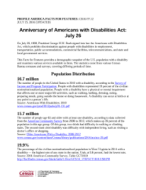Anniversary of Americans with Disabilities Act: July 26
On July 26, 1990, President George H.W. Bush signed into law the Americans with Disabilities Act, which prohibits discrimination against people with disabilities in employment, transportation, public accommodations, commercial facilities, telecommunications, and state and local government services.
This Facts for Features provides a demographic snapshot of the U.S. population with a disability and examines various services available to them. The statistics come from various Census Bureau censuses and surveys, covering differing periods of time.
Population Distribution
56.7 million
The number of people in the United States in 2010 with a disability, according to the Survey of Income and Program Participation. People with disabilities represented 19 percent of the civilian noninstitutionalized population. People with a disability have a physical or mental impairment that affects one or more major life activities, such as walking, bathing, dressing, eating, preparing meals, going outside the home or doing housework. A disability can occur at birth or at any point in a person’s life.
Source:
15.7 million
The number of people age 65 and older with at least one disability, according to data collected from the American Community Survey from 2008 to 2012, which makes up 39 percent of the population in this age group. Of this group, two-thirds had difficulty in walking or climbing stairs. The second-most cited disability was difficulty with independent living, such as visiting a doctor’s office or shopping.
Source:
19.9%
The percentage of the civilian noninstitutionalized population in West Virginia in 2014 with a disability — the highest rate of any state in the nation. Utah, at 9.6 percent, had the lowest rate.
Source:
28.1%
The percentage of the civilian noninstitutionalized population in Pike County, Ky., in 2014 with a disability — among the highest rate in the nation among counties with populations of 65,000 or more. Loudoun County, Va., at 5.5 percent, had among the lowest rates.
Source:
23.2%
The percentage of the civilian noninstitutionalized population in The Villages (CDP), Fla., in 2014 with a disability — among the highest rates in the nation among places with populations of 65,000 or more. San Ramon, Calif., at 4.3 percent, had among the lowest rates. A place is a city, town, village or borough, either legally incorporated or not.
Source:
Services for Those With Disabilities
2,833
The number of business establishments providing special needs transportation in 2012, up 20.7 percent from 2,347 in 2007. Such businesses may use specially equipped vehicles to provide passenger transportation. These businesses employed 61,605 people in 2012 and generated revenues of $3.5 billion. Employment was up 24.0 percent and revenues increased 27.7 percent since 2007.
Source:
14,060
The number of business establishments that provided pet care (except veterinary services) in 2012. These businesses generated revenues of $3.4 billion. Among these businesses are those that train assistance dogs.
Source:
25,964
The number of business establishments providing services for the elderly and people with disabilities in 2012. These businesses employed 901,359 workers and generated $34.1 billion in revenues. In 2007, there were 20,433 such establishments, employing 621,545 people and producing $25.3 billion in revenues. These establishments provide for the welfare of these individuals in such areas as day care, nonmedical home care or homemaker services, social activities, group support and companionship.
Source:
7,832
The number of business establishments providing vocational rehabilitation services in 2012; these businesses employed 312,659 people and generated revenues of $12.4 billion. In 2007, there were 7,631 such establishments, employing 303,713 people and producing revenues of $11.5 billion. These businesses provide job counseling, job training and work experience to people with disabilities.
Source:
2,344
The number of business establishments providing translation and interpretation services in 2012; these businesses employed 24,926 people and generated revenues of $4.2 billion. In 2007, there were 1,975 such establishments, employing 14,546 people and producing revenues of $1.9 billion. Among these businesses are those that provide sign language services.
Source:
3,597
The number of business establishments providing home health equipment rental in 2012, down 4.4 percent from 3,762 in 2007. Such businesses rent home-type health and invalid equipment, such as wheelchairs, hospital beds, oxygen tanks, etc. These businesses employed 33,935 people in 2012 and generated revenues of $5.4 billion. Employment was up 2.8 percent while revenues decreased 7.8 percent since 2007.
Source:
Specific Disabilities
*UPDATED*
Note: All estimates in this section come from the American Community Survey 2014 1-year data, measuring the civilian noninstitutionalized population. //factfinder.census.gov/bkmk/table/1.0/en/ACS/14_1YR/S1810
10.8 million
The number of people age 18 and older in 2014 who were deaf or had significant difficulty hearing. Among people age 65 and older, 6.7 million were deaf or had significant difficulty hearing.
6.8 million
The number of people age 18 and older in 2014 who had serious difficulty seeing even when wearing glasses. Among people age 65 and older, 3.0 million had serious difficulty seeing.
20.6 million
The number of people age 18 and older in 2014 who had serious difficulty walking or climbing stairs. Among people age 65 and older, 10.4 million had serious difficulty walking or climbing stairs.
12.8 million
The number of people age 18 and older in 2014 who had serious difficulty concentrating, remembering, or making decisions due to a physical, mental or emotional condition. Among people age 65 and older, 4.1 million had serious difficulty concentrating, remembering or making decisions.
14.1 million
The number of people age 18 and older in 2014 who had difficulty doing errands alone, such as visiting a doctor’s office or shopping, due to a physical, mental or emotional condition. Among people age 65 and older, 6.8 million had difficulty doing errands alone.
7.4 million
The number of people age 18 and older in 2014 who had difficulty dressing or bathing. Among people age 65 and older, 3.8 million had difficulty dressing or bathing.
Older People With a Disability
Note: The source for the data in this section is Older Americans With a Disability: 2008-2012, which contains data from the 2008 to 2012 American Community Survey.
25.4%
The percentage who were age 85 and older with a disability among the population age 65 and older, according to the 2008-2012 American Community Survey.
More than One-Third
The proportion of people age 85 and older with a disability who lived alone, compared with one-fourth of those age 65 to 74, according to the 2008-2012 American Community Survey.
54.4%
The percentage of the older population who had not graduated from high school and had a disability, twice the rate of those with a bachelor’s degree or higher (26.0 percent), according to the 2008-2012 American Community Survey.
12.6%
The percentage of older Americans living in a household with a disability living in poverty, compared with 7.2 percent of older household population without a disability, according to the 2008-2012 American Community Survey.
Earnings
$21,232
Median earnings in the past 12 months for people with a disability. This is 68 percent of the median earnings, $31,324, for those without a disability. (Both figures pertain to the civilian, noninstitutionalized population 16 years and older, with earnings in the past 12 months.)
Source:
Mobility
Note: The source for the data in this section is Desire to Move and Residential Mobility: 2010-2011, a report which uses data from the Survey of Income and Program Participation.
12.5%
The percentage of householders with a disability who desired to move to another residence, higher than the corresponding figure of 8.2 percent for those without a disability. Those with mental disabilities were the most likely to desire to move (20.6 percent).
17.3%
The percentage of householders with a disability who desired to move to another residence and actually did so over a one-year period.
9.3%
The percentage of all householders with a disability who moved to another residence over a one-year period.
The following is a list of observances typically covered by the Census Bureau’s Facts for Features series:
| Black (African American) History Month (February) Super Bowl Valentine's Day (Feb. 14) Women's History Month (March) Irish-American Heritage Month (March)/ St. Patrick's Day (March 17) Earth Day (April 22) Asian/Pacific American Heritage Month (May) Older Americans Month (May) Mother's Day Hurricane Season Begins (June 1) Father's Day |
The Fourth of July (July 4) Anniversary of Americans With Disabilities Act (July 26) Back to School (August) Labor Day Grandparents Day Hispanic Heritage Month (Sept. 15-Oct. 15) Unmarried and Single Americans Week Halloween (Oct. 31) American Indian/Alaska Native Heritage Month (November) Veterans Day (Nov. 11) Thanksgiving Day The Holiday Season (December) |
Editor’s note: The preceding data were collected from a variety of sources and may be subject to sampling variability and other sources of error. Facts for Features are customarily released about two months before an observance in order to accommodate magazine production timelines. Questions or comments should be directed to the Census Bureau’s Public Information Office: telephone: 301-763-3030; or e-mail: pio@census.gov.










